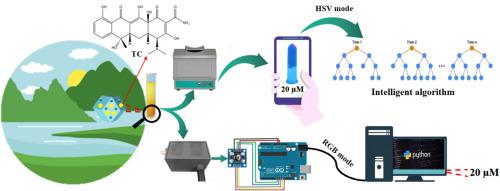Ratiometric probe AMC@ZIF-8 integrating intelligent algorithm and HSV mode for visual on-site detection of tetracycline in environmental water samples
IF 4.6
2区 化学
Q1 SPECTROSCOPY
Spectrochimica Acta Part A: Molecular and Biomolecular Spectroscopy
Pub Date : 2025-09-25
DOI:10.1016/j.saa.2025.126995
引用次数: 0
Abstract
The residues of tetracycline (TC) in the environment pose a serious threat to ecosystems and human health, and it is difficult to meet the on-site rapid monitoring requirements. Therefore, the development of an intelligent, portable, visualized detection device for TC is of great significance for achieving real-time environmental monitoring and accessible food safety control. Herein, a non-fluorescent metal-organic framework material (ZIF-8) was combined with blue-emitting 7-amino-4-methylcoumarin (AMC) via electrostatic interaction to construct a high-efficiency ratiometric probe AMC@ZIF-8 for the detection of TC. The blue fluorescence of AMC, which did not react with TC, serving as the reference signal at 452 nm, while the aggregation-induced emission (AIE) effect between TC and ZIF-8 produced a yellow-green fluorescence at 525 nm, using as the response signal. Therefore, a linear relationship between the AMC@ZIF-8 composite and the added TC was obtained over the range of 0.03–40 μM. This ratiometric fluorescent probe demonstrated recovery rates of 95.4 %–107.8 % (RSD ≤ 4 %) in real water samples, with a detection limit as low as 10.08 nM. Furthermore, an intelligent application based on the random forest algorithm was developed, which could extract hue, saturation, and value features from the HSV color space. The model achieved a test set accuracy of 99.41 % within the 0–50 μM concentration range. The application integrates image acquisition, feature extraction, and visual concentration prediction functions, and supports real-time analysis on smartphones, offering a low-cost, high-accuracy semi-quantitative solution for food safety and environmental monitoring.

结合智能算法和HSV模式的比例探针AMC@ZIF-8用于环境水样中四环素的现场视觉检测。
四环素在环境中的残留对生态系统和人类健康构成严重威胁,难以满足现场快速监测的要求。因此,开发一种智能、便携、可视化的TC检测装置,对于实现环境实时监测和食品安全无障碍控制具有重要意义。本文将非荧光金属-有机骨架材料(ZIF-8)与蓝色发光的7-氨基-4-甲基香豆素(AMC)通过静电相互作用结合,构建了用于检测TC的高效比例探针AMC@ZIF-8。未与TC发生反应的AMC的蓝色荧光在452nm处作为参比信号,TC与ZIF-8的聚集诱导发射(AIE)效应在525nm处产生黄绿色荧光作为响应信号。因此,AMC@ZIF-8复合材料与加入的TC在0.03 ~ 40 μM范围内呈线性关系。该比例荧光探针在实际水样中的回收率为95.4% ~ 107.8% (RSD≤4%),检出限低至10.08 nM。在此基础上,开发了一种基于随机森林算法的智能应用程序,可以从HSV色彩空间中提取色调、饱和度和值特征。该模型在0 ~ 50 μM浓度范围内的测试集精度达到99.41%。该应用集图像采集、特征提取、视觉浓度预测等功能于一体,支持智能手机实时分析,为食品安全和环境监测提供低成本、高精度的半定量解决方案。
本文章由计算机程序翻译,如有差异,请以英文原文为准。
求助全文
约1分钟内获得全文
求助全文
来源期刊
CiteScore
8.40
自引率
11.40%
发文量
1364
审稿时长
40 days
期刊介绍:
Spectrochimica Acta, Part A: Molecular and Biomolecular Spectroscopy (SAA) is an interdisciplinary journal which spans from basic to applied aspects of optical spectroscopy in chemistry, medicine, biology, and materials science.
The journal publishes original scientific papers that feature high-quality spectroscopic data and analysis. From the broad range of optical spectroscopies, the emphasis is on electronic, vibrational or rotational spectra of molecules, rather than on spectroscopy based on magnetic moments.
Criteria for publication in SAA are novelty, uniqueness, and outstanding quality. Routine applications of spectroscopic techniques and computational methods are not appropriate.
Topics of particular interest of Spectrochimica Acta Part A include, but are not limited to:
Spectroscopy and dynamics of bioanalytical, biomedical, environmental, and atmospheric sciences,
Novel experimental techniques or instrumentation for molecular spectroscopy,
Novel theoretical and computational methods,
Novel applications in photochemistry and photobiology,
Novel interpretational approaches as well as advances in data analysis based on electronic or vibrational spectroscopy.

 求助内容:
求助内容: 应助结果提醒方式:
应助结果提醒方式:


